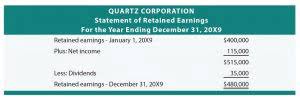
You can also finance new products, pay debts, or pay stock or cash dividends. This must come before the deduction of operating expenses and overhead costs. Some industries refer to revenue as gross sales because its gross figure gets calculated before deductions. As a result, additional paid-in capital is the amount of equity available to fund growth. And since expansion typically leads to higher profits and higher net income in the long-term, additional paid-in capital can have a positive impact on retained earnings, albeit an indirect impact. Additional paid-in capital is included in shareholder equity and can arise from issuing either preferred stock or common stock.
Accumulated Deficits

However, established companies usually pay a portion of their retained earnings out as dividends while also reinvesting a portion back into the company. Retained earnings are calculated by subtracting a company’s total dividends paid to shareholders from its net income. This gives you the amount of profits that have been reinvested back into the business. A company’s shareholder equity is calculated by subtracting total liabilities from its total assets. Shareholder equity represents the amount left over for shareholders if a company pays off all of its liabilities. To see how retained earnings impact shareholders’ equity, let’s look at an example.
Use an income statement to figure out your profit
To calculate RE, the beginning RE balance is added to the net income or reduced by a net loss and then dividend payouts are subtracted. A summary report called a statement of retained earnings is also maintained, outlining the changes in RE for a specific period. Cash payment of dividends leads to cash outflow and is recorded in the books and accounts as net reductions. As the company loses ownership of its liquid assets in the form of cash dividends, it reduces the company’s asset value on the balance sheet, thereby impacting RE. Retained earnings accumulate all profits and losses from when a company starts operating.
Where to find retained earnings in the balance sheet?
- This is just a dividend payment made in shares of a company, rather than cash.
- Retained earnings are the portion of the profit saved to make shareholder dividend payments or for other future uses, such as growing the company and/or product lines or paying off debts.
- The company can influence equity (in small amounts) by adjusting the dividends paid for the year.
- Company revenue is a line item at the top of the income statement.
The resultant number may be either positive or negative, depending upon the net income or loss generated by the company over time. Alternatively, the company paying large dividends that exceed the other figures can also lead to the retained earnings going negative. Essentially, retained earnings include all profits a company makes. This amount comes after deducting all expenses for a period from the total income. When these amounts accumulate for several periods, they go to the retained earnings account. However, these amounts only include profits not paid to shareholders in previous periods.
What’s the Retained Earnings Formula?
Shareholder equity influences the return generated concerning the total amount invested by equity investors. This is because years of retained earnings could be used for expenses or any asset to help the business grow. Bondholders are paid and liquidated before preferred shareholders, born and liquidated before common shareholders. https://www.bookstime.com/articles/amortizing-bond-premium-with-the-effective-interest-rate-method Is the most widely used formula to calculate the stockholder’s equity. If the value of all assets exceeds the value of all liabilities, the equity is positive and indicates a thriving business. Also known as Owner’s Equity, is the total amount of assets remaining after deducting all liabilities from the company.

Although the level of risk influences many investment decisions we are willing to take, we cannot ignore all the critical components discussed above. Are you still wondering about calculating and interpreting retained earnings? If the company is experiencing a net loss on its Income Statement, then the net loss is subtracted from the existing retained earnings.

Calculate and Subtract Dividends Paid to Shareholders in Current Period
Like in a general partnership, profits of an LLC are generally distributed to the shareholders. Any profits that are not distributed at the end of the LLC’s tax year are considered retained earnings asset or liability retained earnings. Undistributed profit is shown in the books as retained earnings. You can track your company’s retained earnings by reviewing its financial statements.
How to Calculate Retained Earnings: Formula and Example

However, if you want a good idea of how your operations are doing, income should not be your only focus. As a result, from an investor’s perspective, debt is the least risky investment. For businesses, it is the cheapest source of financing because interest payments are tax-deductible, and debt generally provides a lower return to investors.
